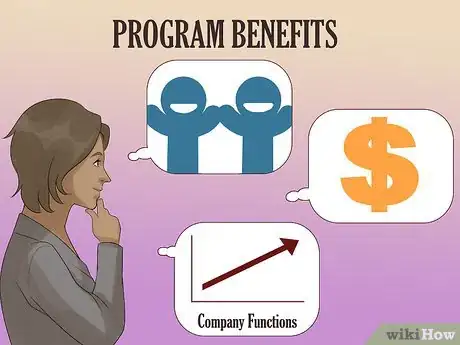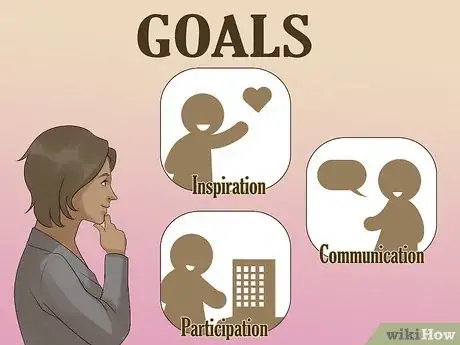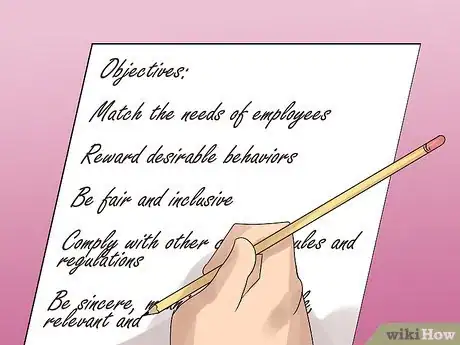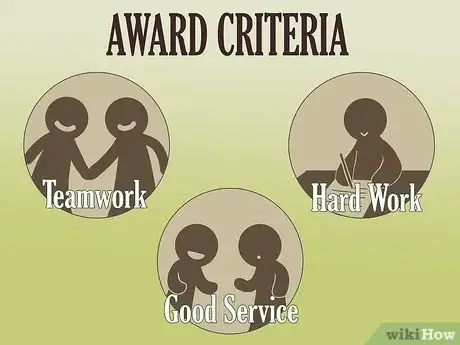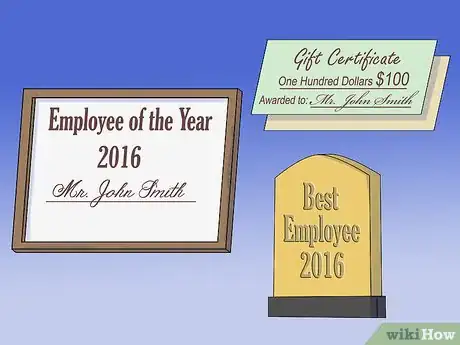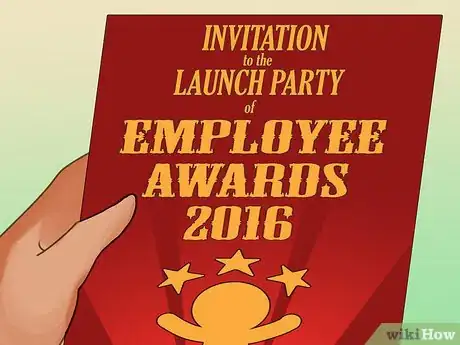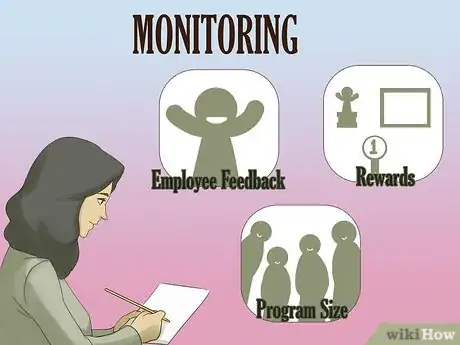This article was co-authored by wikiHow Staff. Our trained team of editors and researchers validate articles for accuracy and comprehensiveness. wikiHow's Content Management Team carefully monitors the work from our editorial staff to ensure that each article is backed by trusted research and meets our high quality standards.
This article has been viewed 23,254 times.
Learn more...
Your employees work hard and recognizing their hard work can be a great way to let them know that you appreciate their efforts. One way to recognize your employee's contribution is to create an employee recognition program. This program will allow your employees to demonstrate their achievements, foster company values, and improve overall workplace efficiency and atmosphere. You'll need to carefully plan your program, decide who will be involved, and clearly inform your employees about it to help ensure it is a success.
Steps
Laying the Program's Groundwork
-
1Understand the benefits of the program. Employee recognition programs are designed to let employees know that their hard work is appreciated. Beyond letting your employees know that they are valued, these programs can also help boost productivity and performance. Before you create your employee recognition program, take a look at some of the main benefits that a program like this can bring:[1] [2]
- Gain a better understanding of how you can improve company functions and policy.
- Learn where you could save money and cut expenses.
- Encourage your employees to go above and beyond regular duties.
- Improve attitudes and teamwork.
-
2Discover what the main goals of any program should be. Although the specifics of your employee recognition program will be up to you, there are some common goals that all good programs will share. Knowing the basic goals can help make your program a success. Take a look at some of the following common goals to help you create a great employee recognition program.[3] [4]
- Your program should inspire employees to be their best.
- You'll need to learn how to clearly communicate your goals, needs, and expectations to those participating in your program.
- Your employees should know how to participate in the program.
- Let employees know how they make an impact on the company.
Advertisement -
3Include formal and informal recognition. A good employee recognition program will have two methods of rewarding performance. These methods will allow your employees to feel recognized both personally and officially. Take a look at some of these examples of formal and informal rewards for your own program:[5]
- Covering for someone who is ill, staying late to work on a project with a coworker or going the extra mile for your team are all good examples of informal recognition.
- Your official rewards program will deliver formal recognition for your employee's hard work.
Creating the Program
-
1Set up a committee. The first step in forming your employee recognition program will be to form a committee. The committee will handle the formation of the program, it's implementation, and the management of it once it's established. To help you form your committee, keep some of these tips in mind:[6] [7]
- It can be a good idea to mix both employees and managers on your committee.
- You'll want to determine how long members are appointed to the committee.
- You should decide how members are selected to serve on the committee.
- Decide how many members you will need for your group.
-
2Outline the program's objectives. Your employee recognition program will need to have clear objectives. These objectives will help your program have direct goals and develop steps to achieve them. A good employee recognition program will:[8]
- Match the needs of your employees.
- Reward desirable behaviors.
- Be fair and inclusive.
- Comply with other company rules and regulations.
- Be sincere, meaningful, adaptable, relevant, and timely.
-
3Define the criteria for awards. In order to offer rewards for certain actions, you'll need to decide which actions should be rewarded. Knowing which behaviors and actions lead to a reward can help you create a sensible and effective program. Any award criteria should encourage and reward key behaviors that you want to foster in your company. Review the following examples of behavioral criteria to learn which might be a good fit for your program: [9] [10]
- Excellent customer service
- Being a good leader
- Putting in extra effort
- Performing professional duties well
- Being a good team member
- Demonstrating flexibility or being innovative
-
4Think about which rewards you want to offer. After you've decided which behaviors you want to reward, you'll need to decide how you want to reward them. Your rewards could by anything, but they should be sincere, genuine and something that your employees feel is valuable or worth earning. You might consider using some of these examples when thinking about which rewards you want to offer to your employees:
- Framed certificates of excellence.
- Gift certificates.
- Plaques
- Tickets to local events
- Gift cards
- Pins or stickers
-
5Decide who can earn an award and when. Now that you know which behaviors are rewarded and how you plan on rewarding them, you can decide how often to offer those rewards. The committee tasked with building your recognition program will need to choose which employees are eligible for a reward, when they can receive an award and how often rewards are issued.[11] [12]
- You'll want to decide how many awards an employee could win.
- Decide how often an employee can win an award.
- You should choose a regular time to send out rewards.
- You will need to select which employees are eligible for a reward. For example, you may choose to offer rewards to only full-time employees or employees that have worked with the company for a number of years.
-
6Decide the nomination and selection procedures. After you decide who is eligible for a reward and when, you'll want to determine how they can be nominated for those rewards. You will also need to decide how you select the recipients of awards, making it clear who can win the award and when. Work with your committee to answer some of these questions regarding your employee recognition program: [13]
- Will nominations be kept confidential or will they be public?
- Who can submit nominations?
- What information about a nominee should be provided?
- How should nominations be submitted?
- Who will review nominations?
- Who will be deciding the recipients of awards.
Launching the Recognition Program
-
1Advertise your program. Once you have the framework of your employee recognition program in place, you'll want to start promoting it. Getting employees excited and interested in the program can help them take part in it once you officially begin. Your employees will also know what to expect from the program, how to participate, and which rewards they can earn. Try promoting your program by using some of these methods: [14] [15]
- Send detailed emails out to employees.
- Include information about the program in your company's newsletter.
- Promote the program on your company's website.
- Post details of the program on company bulletin boards.
- Hold meetings and discuss the program.
-
2Launch the program. Now that your program has been finalized and your employees have been made aware of it, it's time to officially launch the program. You'll want to have a clear start date for the program, allowing you to carefully track the effect it has on your company and to allow your employees to know when they can begin taking part. Make sure everyone at your company is aware of the recognition program to help make it a success.
- You might have a small event or ceremony to build excitement and launch your program.
- Keep track of employee engagement levels as your program beings.
- You'll want to begin looking for any increase in the performance targets the program was designed around.
-
3Monitor the program. After your program launches, all that's left to do is make sure it's running properly. Carefully tracking the program will allow you to determine how well it's working, the effect it's having on your employees, and any changes that you might need to make. Keep track of the program and monitor its success to help engage your employees and recognize them for their hard work. [16] [17]
- You'll want to track how satisfied employees are with the program.
- You may need to change employee eligibility requirements for your program.
- You may decide to offer different rewards.
- You may need to assign more people to the reward program committee.
- You might need to adjust the size of your program due to available funding.
References
- ↑ https://www2.indstate.edu/humres/docs/GuideEmpRecognition7-25-11.docx
- ↑ https://www.washington.edu/admin/hr/roles/mgr/ee-recognition/develop-progrm.html#step5
- ↑ https://www2.indstate.edu/humres/docs/GuideEmpRecognition7-25-11.docx
- ↑ http://www.morganbrown.com/docs/Recognition%20programs%203-07.pdf
- ↑ https://www2.indstate.edu/humres/docs/GuideEmpRecognition7-25-11.docx
- ↑ https://www2.indstate.edu/humres/docs/GuideEmpRecognition7-25-11.docx
- ↑ https://www.washington.edu/admin/hr/roles/mgr/ee-recognition/develop-progrm.html#step5
- ↑ https://www2.indstate.edu/humres/docs/GuideEmpRecognition7-25-11.docx
- ↑ https://www2.indstate.edu/humres/docs/GuideEmpRecognition7-25-11.docx
- ↑ https://www.washington.edu/admin/hr/roles/mgr/ee-recognition/develop-progrm.html#step5
- ↑ https://www2.indstate.edu/humres/docs/GuideEmpRecognition7-25-11.docx
- ↑ https://www.washington.edu/admin/hr/roles/mgr/ee-recognition/develop-progrm.html#step5
- ↑ https://www2.indstate.edu/humres/docs/GuideEmpRecognition7-25-11.docx
- ↑ https://www2.indstate.edu/humres/docs/GuideEmpRecognition7-25-11.docx
- ↑ https://www.washington.edu/admin/hr/roles/mgr/ee-recognition/develop-progrm.html#step5
- ↑ https://www2.indstate.edu/humres/docs/GuideEmpRecognition7-25-11.docx
- ↑ https://www.washington.edu/admin/hr/roles/mgr/ee-recognition/develop-progrm.html#step5
